LCBB5004 Managing People: Employee Engagement Strategies Report
VerifiedAdded on 2023/06/16
|11
|2668
|360
Report
AI Summary
This report provides a detailed analysis of employee engagement within the context of managing people. It begins by defining employee engagement and exploring its key drivers, such as work environment, leadership, motivation, team building, learning opportunities, and employee well-being. The report then examines diagnostic tools used to measure employee engagement, including pulse surveys, voluntary employee turnover rate, employee absenteeism rate, driver's analysis, continuous communication, and feedback mechanisms. Furthermore, the report discusses the Employee Value Proposition (EVP) as a tool for attracting and retaining talent, highlighting strategies to raise EVP levels, such as promoting work-life balance, recognizing employee achievements, encouraging skill development, and offering competitive rewards and benefits. The overall aim is to provide insights into creating a highly engaged and productive workforce.

Managing People
Paraphrase This Document
Need a fresh take? Get an instant paraphrase of this document with our AI Paraphraser
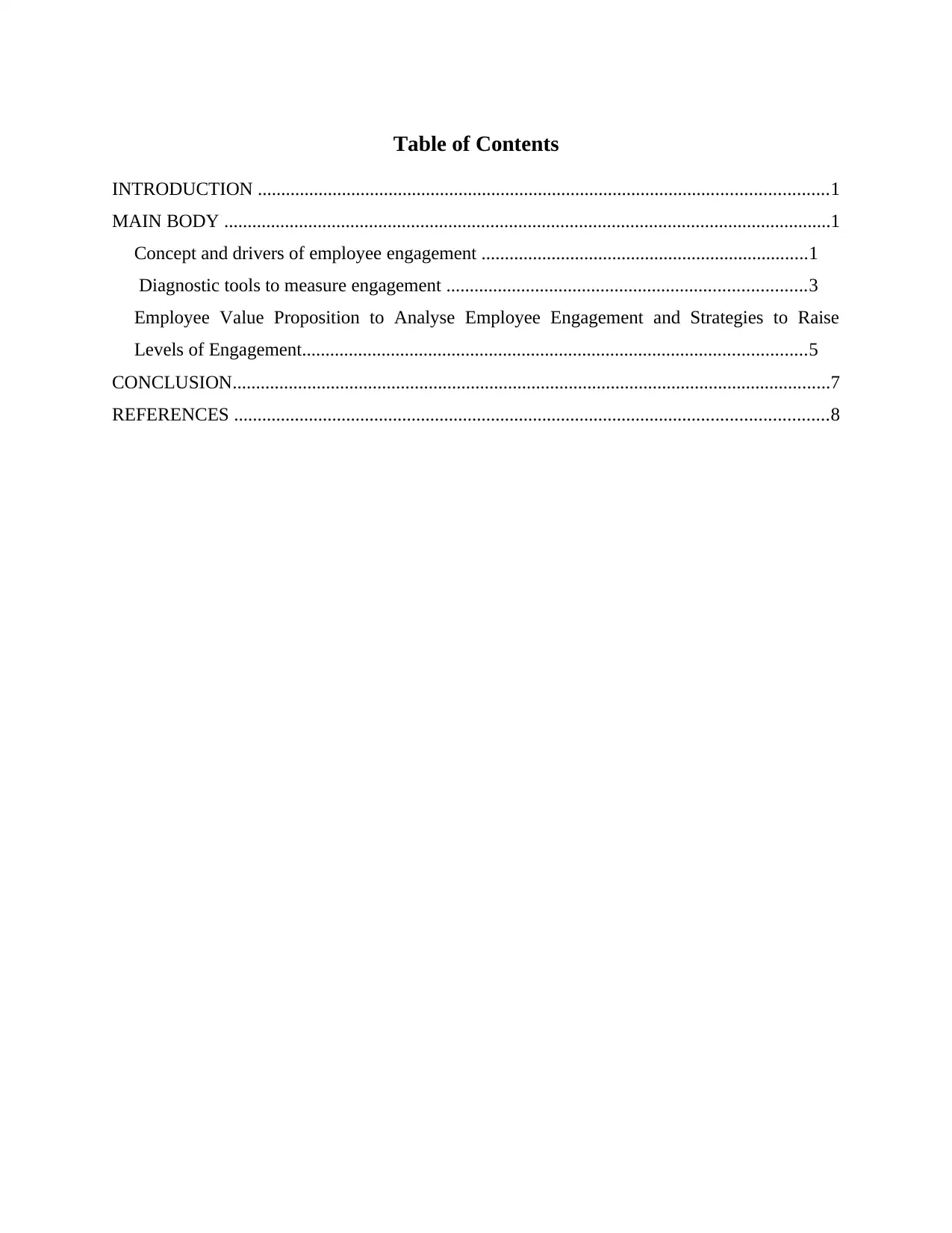
Table of Contents
INTRODUCTION ..........................................................................................................................1
MAIN BODY ..................................................................................................................................1
Concept and drivers of employee engagement ......................................................................1
Diagnostic tools to measure engagement .............................................................................3
Employee Value Proposition to Analyse Employee Engagement and Strategies to Raise
Levels of Engagement............................................................................................................5
CONCLUSION................................................................................................................................7
REFERENCES ...............................................................................................................................8
INTRODUCTION ..........................................................................................................................1
MAIN BODY ..................................................................................................................................1
Concept and drivers of employee engagement ......................................................................1
Diagnostic tools to measure engagement .............................................................................3
Employee Value Proposition to Analyse Employee Engagement and Strategies to Raise
Levels of Engagement............................................................................................................5
CONCLUSION................................................................................................................................7
REFERENCES ...............................................................................................................................8
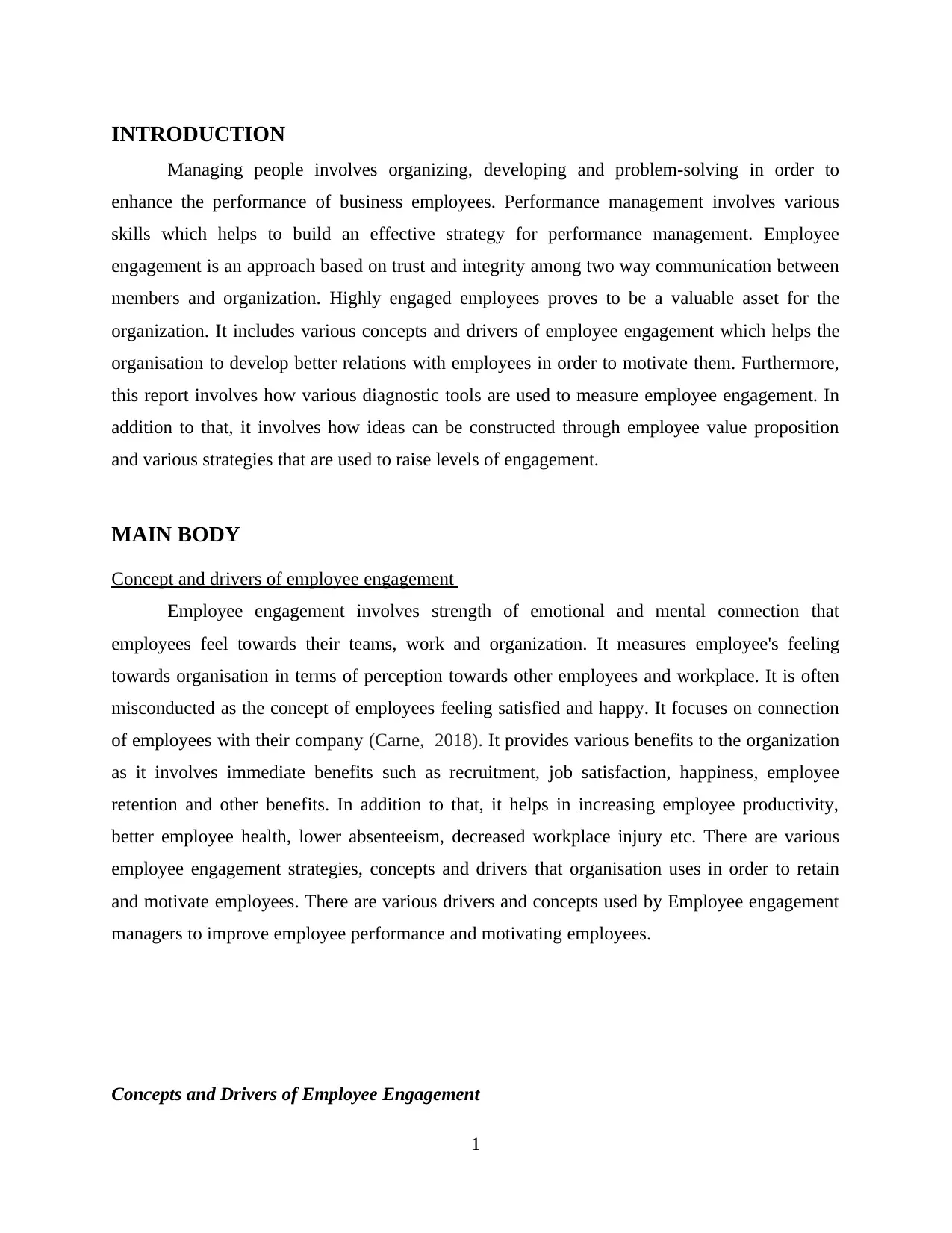
INTRODUCTION
Managing people involves organizing, developing and problem-solving in order to
enhance the performance of business employees. Performance management involves various
skills which helps to build an effective strategy for performance management. Employee
engagement is an approach based on trust and integrity among two way communication between
members and organization. Highly engaged employees proves to be a valuable asset for the
organization. It includes various concepts and drivers of employee engagement which helps the
organisation to develop better relations with employees in order to motivate them. Furthermore,
this report involves how various diagnostic tools are used to measure employee engagement. In
addition to that, it involves how ideas can be constructed through employee value proposition
and various strategies that are used to raise levels of engagement.
MAIN BODY
Concept and drivers of employee engagement
Employee engagement involves strength of emotional and mental connection that
employees feel towards their teams, work and organization. It measures employee's feeling
towards organisation in terms of perception towards other employees and workplace. It is often
misconducted as the concept of employees feeling satisfied and happy. It focuses on connection
of employees with their company (Carne, 2018). It provides various benefits to the organization
as it involves immediate benefits such as recruitment, job satisfaction, happiness, employee
retention and other benefits. In addition to that, it helps in increasing employee productivity,
better employee health, lower absenteeism, decreased workplace injury etc. There are various
employee engagement strategies, concepts and drivers that organisation uses in order to retain
and motivate employees. There are various drivers and concepts used by Employee engagement
managers to improve employee performance and motivating employees.
Concepts and Drivers of Employee Engagement
1
Managing people involves organizing, developing and problem-solving in order to
enhance the performance of business employees. Performance management involves various
skills which helps to build an effective strategy for performance management. Employee
engagement is an approach based on trust and integrity among two way communication between
members and organization. Highly engaged employees proves to be a valuable asset for the
organization. It includes various concepts and drivers of employee engagement which helps the
organisation to develop better relations with employees in order to motivate them. Furthermore,
this report involves how various diagnostic tools are used to measure employee engagement. In
addition to that, it involves how ideas can be constructed through employee value proposition
and various strategies that are used to raise levels of engagement.
MAIN BODY
Concept and drivers of employee engagement
Employee engagement involves strength of emotional and mental connection that
employees feel towards their teams, work and organization. It measures employee's feeling
towards organisation in terms of perception towards other employees and workplace. It is often
misconducted as the concept of employees feeling satisfied and happy. It focuses on connection
of employees with their company (Carne, 2018). It provides various benefits to the organization
as it involves immediate benefits such as recruitment, job satisfaction, happiness, employee
retention and other benefits. In addition to that, it helps in increasing employee productivity,
better employee health, lower absenteeism, decreased workplace injury etc. There are various
employee engagement strategies, concepts and drivers that organisation uses in order to retain
and motivate employees. There are various drivers and concepts used by Employee engagement
managers to improve employee performance and motivating employees.
Concepts and Drivers of Employee Engagement
1
⊘ This is a preview!⊘
Do you want full access?
Subscribe today to unlock all pages.

Trusted by 1+ million students worldwide

There are various drivers and concepts used in order to measure employee
experience and motivation which involves the following concepts and drivers. Work Environment and Organizational Culture:
Bond between organization and employees defines the organizational culture and
work environment. An employee performs better and is highly motivated if he or she feels
supportive in the work environment. Other factors that helps in motivating employees
includes open communication, organization policy, quality of interaction with peers,
organization performance etc. all these are highly contributing to employee engagement
process (Dietz, 2020).
Leadership:
It is the process of influencing the behaviour of people by making them strive
voluntarily towards attainment of organizational goals. If the employees are not satisfied
with their superiors, they can never feel motivated to perform well in the organization. In
order to get results, organizations need to invest effort and time in grooming leaders.
Motivating Employees:
Motivated employees are highly valuable for any organization as employees who
are motivated results in better performance and achievement of targets. The managers need
to understand and should regularly use various motivational factors such as appraisal,
promotion, job recognition etc.
Team Building:
Working as a team helps an individual employee to feel better and achieve its
targets in effective manner. It involves various factors that enhances social relations and
involves collaborative tasks. Various activities are undertaken to increase motivation and
boost cooperation. This also involves building opportunities for leadership propositions for
employees (Greenberg, 2020).
Learning and Development Opportunities:
Learning and development opportunities involves online training, peer coaching,
stretch assignments, coaching and mentorship. By enhancing overall improvement and
growth, employers can invest in long term growth and success. In order to engage and
stimulate in workforce, learning and development plays an important role.
Well-being of employees:
Due to COVID, there has been various changes in people's lives. Due to pandemic
scenario, various changes had been implemented in employee engagement programs and
employers are taking extra care for the wellbeing of employees. This creates a friendly
working environment and enhances a sense of belongingness.
Strategies and Concepts of Employee Engagement:
Employee engagement strategies involves creation of an environment which
involves increasing the employees’ likelihood towards organization. There are various
2
experience and motivation which involves the following concepts and drivers. Work Environment and Organizational Culture:
Bond between organization and employees defines the organizational culture and
work environment. An employee performs better and is highly motivated if he or she feels
supportive in the work environment. Other factors that helps in motivating employees
includes open communication, organization policy, quality of interaction with peers,
organization performance etc. all these are highly contributing to employee engagement
process (Dietz, 2020).
Leadership:
It is the process of influencing the behaviour of people by making them strive
voluntarily towards attainment of organizational goals. If the employees are not satisfied
with their superiors, they can never feel motivated to perform well in the organization. In
order to get results, organizations need to invest effort and time in grooming leaders.
Motivating Employees:
Motivated employees are highly valuable for any organization as employees who
are motivated results in better performance and achievement of targets. The managers need
to understand and should regularly use various motivational factors such as appraisal,
promotion, job recognition etc.
Team Building:
Working as a team helps an individual employee to feel better and achieve its
targets in effective manner. It involves various factors that enhances social relations and
involves collaborative tasks. Various activities are undertaken to increase motivation and
boost cooperation. This also involves building opportunities for leadership propositions for
employees (Greenberg, 2020).
Learning and Development Opportunities:
Learning and development opportunities involves online training, peer coaching,
stretch assignments, coaching and mentorship. By enhancing overall improvement and
growth, employers can invest in long term growth and success. In order to engage and
stimulate in workforce, learning and development plays an important role.
Well-being of employees:
Due to COVID, there has been various changes in people's lives. Due to pandemic
scenario, various changes had been implemented in employee engagement programs and
employers are taking extra care for the wellbeing of employees. This creates a friendly
working environment and enhances a sense of belongingness.
Strategies and Concepts of Employee Engagement:
Employee engagement strategies involves creation of an environment which
involves increasing the employees’ likelihood towards organization. There are various
2
Paraphrase This Document
Need a fresh take? Get an instant paraphrase of this document with our AI Paraphraser
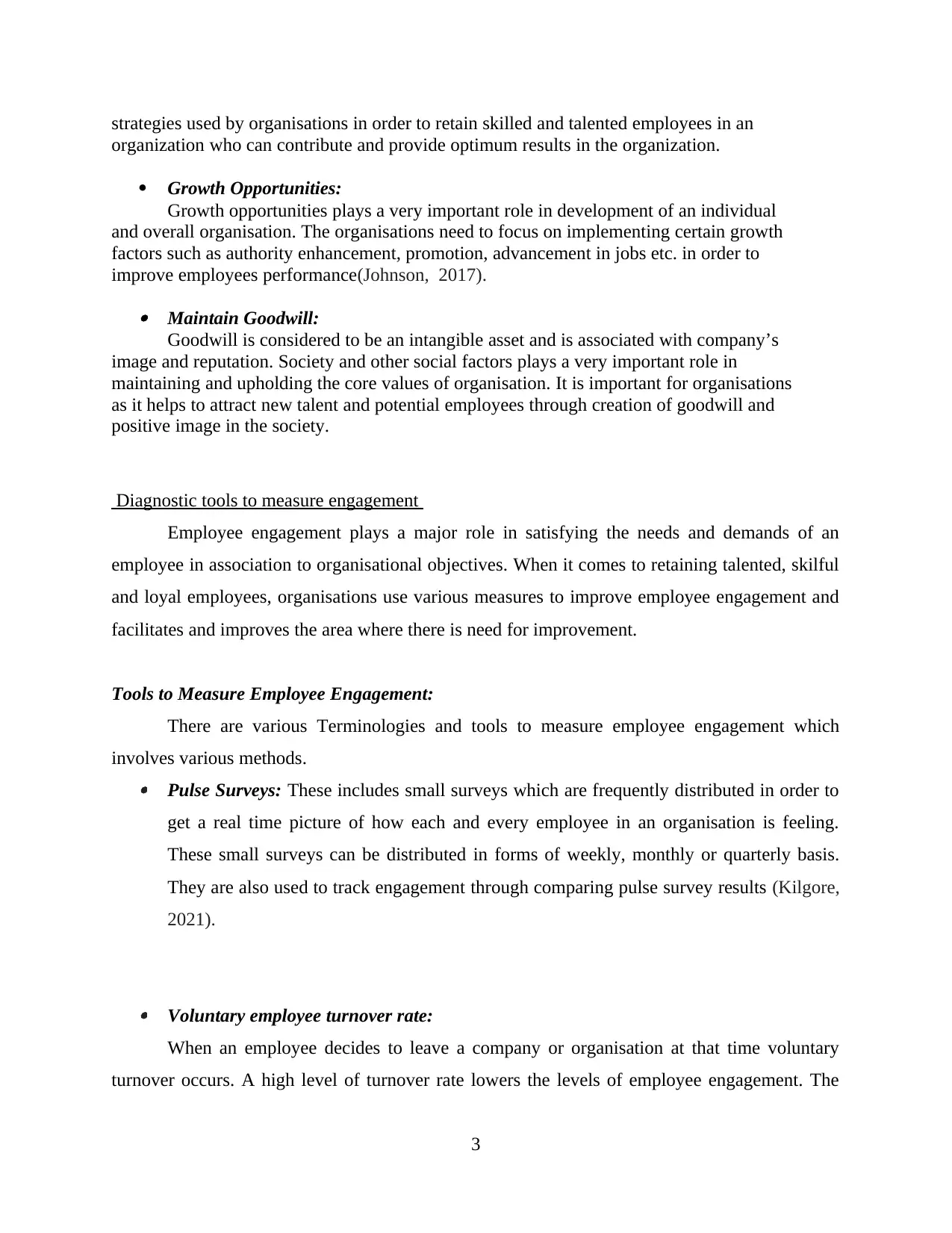
strategies used by organisations in order to retain skilled and talented employees in an
organization who can contribute and provide optimum results in the organization.
Growth Opportunities:
Growth opportunities plays a very important role in development of an individual
and overall organisation. The organisations need to focus on implementing certain growth
factors such as authority enhancement, promotion, advancement in jobs etc. in order to
improve employees performance(Johnson, 2017). Maintain Goodwill:
Goodwill is considered to be an intangible asset and is associated with company’s
image and reputation. Society and other social factors plays a very important role in
maintaining and upholding the core values of organisation. It is important for organisations
as it helps to attract new talent and potential employees through creation of goodwill and
positive image in the society.
Diagnostic tools to measure engagement
Employee engagement plays a major role in satisfying the needs and demands of an
employee in association to organisational objectives. When it comes to retaining talented, skilful
and loyal employees, organisations use various measures to improve employee engagement and
facilitates and improves the area where there is need for improvement.
Tools to Measure Employee Engagement:
There are various Terminologies and tools to measure employee engagement which
involves various methods. Pulse Surveys: These includes small surveys which are frequently distributed in order to
get a real time picture of how each and every employee in an organisation is feeling.
These small surveys can be distributed in forms of weekly, monthly or quarterly basis.
They are also used to track engagement through comparing pulse survey results (Kilgore,
2021).
Voluntary employee turnover rate:
When an employee decides to leave a company or organisation at that time voluntary
turnover occurs. A high level of turnover rate lowers the levels of employee engagement. The
3
organization who can contribute and provide optimum results in the organization.
Growth Opportunities:
Growth opportunities plays a very important role in development of an individual
and overall organisation. The organisations need to focus on implementing certain growth
factors such as authority enhancement, promotion, advancement in jobs etc. in order to
improve employees performance(Johnson, 2017). Maintain Goodwill:
Goodwill is considered to be an intangible asset and is associated with company’s
image and reputation. Society and other social factors plays a very important role in
maintaining and upholding the core values of organisation. It is important for organisations
as it helps to attract new talent and potential employees through creation of goodwill and
positive image in the society.
Diagnostic tools to measure engagement
Employee engagement plays a major role in satisfying the needs and demands of an
employee in association to organisational objectives. When it comes to retaining talented, skilful
and loyal employees, organisations use various measures to improve employee engagement and
facilitates and improves the area where there is need for improvement.
Tools to Measure Employee Engagement:
There are various Terminologies and tools to measure employee engagement which
involves various methods. Pulse Surveys: These includes small surveys which are frequently distributed in order to
get a real time picture of how each and every employee in an organisation is feeling.
These small surveys can be distributed in forms of weekly, monthly or quarterly basis.
They are also used to track engagement through comparing pulse survey results (Kilgore,
2021).
Voluntary employee turnover rate:
When an employee decides to leave a company or organisation at that time voluntary
turnover occurs. A high level of turnover rate lowers the levels of employee engagement. The
3
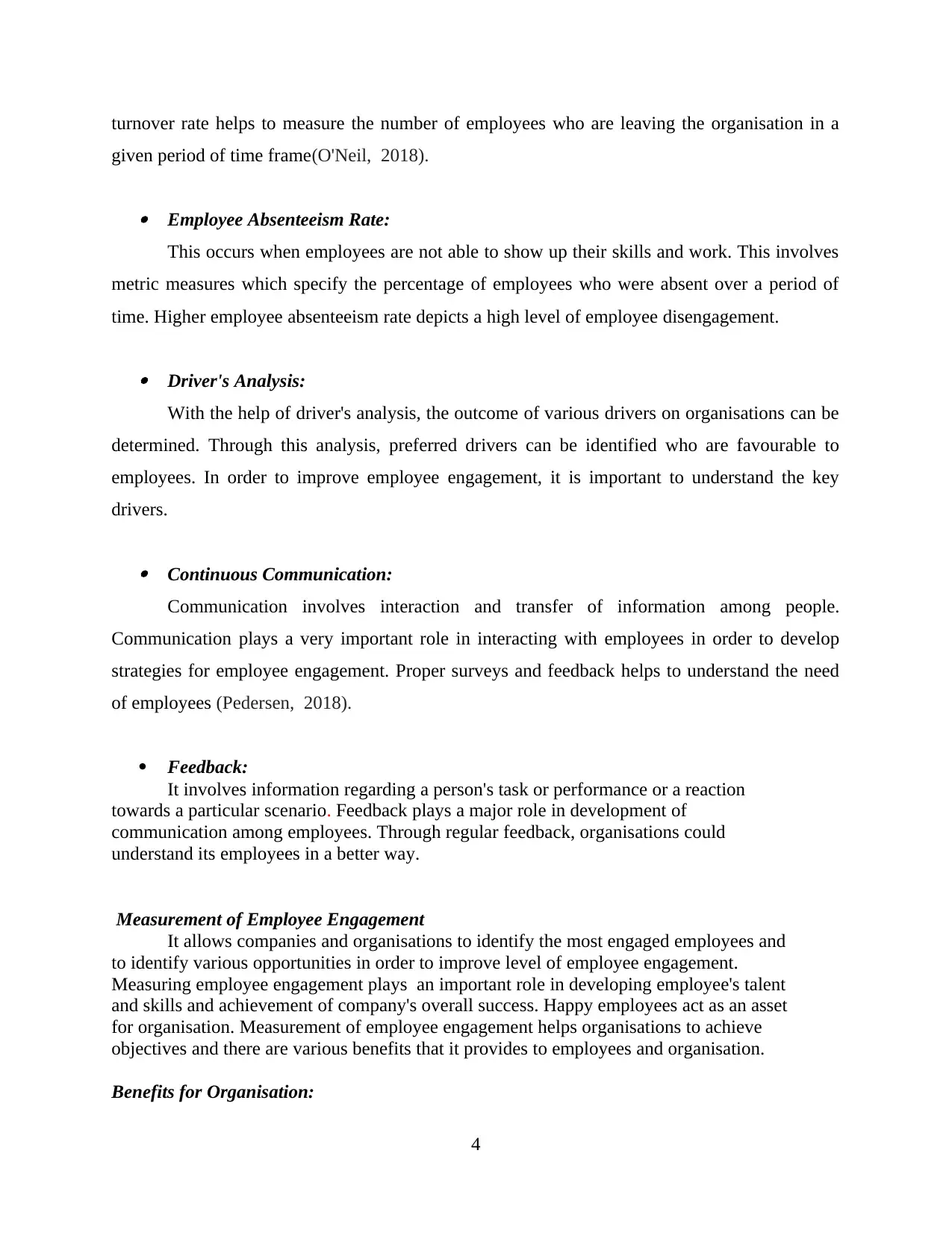
turnover rate helps to measure the number of employees who are leaving the organisation in a
given period of time frame(O'Neil, 2018).
Employee Absenteeism Rate:
This occurs when employees are not able to show up their skills and work. This involves
metric measures which specify the percentage of employees who were absent over a period of
time. Higher employee absenteeism rate depicts a high level of employee disengagement.
Driver's Analysis:
With the help of driver's analysis, the outcome of various drivers on organisations can be
determined. Through this analysis, preferred drivers can be identified who are favourable to
employees. In order to improve employee engagement, it is important to understand the key
drivers.
Continuous Communication:
Communication involves interaction and transfer of information among people.
Communication plays a very important role in interacting with employees in order to develop
strategies for employee engagement. Proper surveys and feedback helps to understand the need
of employees (Pedersen, 2018).
Feedback:
It involves information regarding a person's task or performance or a reaction
towards a particular scenario. Feedback plays a major role in development of
communication among employees. Through regular feedback, organisations could
understand its employees in a better way.
Measurement of Employee Engagement
It allows companies and organisations to identify the most engaged employees and
to identify various opportunities in order to improve level of employee engagement.
Measuring employee engagement plays an important role in developing employee's talent
and skills and achievement of company's overall success. Happy employees act as an asset
for organisation. Measurement of employee engagement helps organisations to achieve
objectives and there are various benefits that it provides to employees and organisation.
Benefits for Organisation:
4
given period of time frame(O'Neil, 2018).
Employee Absenteeism Rate:
This occurs when employees are not able to show up their skills and work. This involves
metric measures which specify the percentage of employees who were absent over a period of
time. Higher employee absenteeism rate depicts a high level of employee disengagement.
Driver's Analysis:
With the help of driver's analysis, the outcome of various drivers on organisations can be
determined. Through this analysis, preferred drivers can be identified who are favourable to
employees. In order to improve employee engagement, it is important to understand the key
drivers.
Continuous Communication:
Communication involves interaction and transfer of information among people.
Communication plays a very important role in interacting with employees in order to develop
strategies for employee engagement. Proper surveys and feedback helps to understand the need
of employees (Pedersen, 2018).
Feedback:
It involves information regarding a person's task or performance or a reaction
towards a particular scenario. Feedback plays a major role in development of
communication among employees. Through regular feedback, organisations could
understand its employees in a better way.
Measurement of Employee Engagement
It allows companies and organisations to identify the most engaged employees and
to identify various opportunities in order to improve level of employee engagement.
Measuring employee engagement plays an important role in developing employee's talent
and skills and achievement of company's overall success. Happy employees act as an asset
for organisation. Measurement of employee engagement helps organisations to achieve
objectives and there are various benefits that it provides to employees and organisation.
Benefits for Organisation:
4
⊘ This is a preview!⊘
Do you want full access?
Subscribe today to unlock all pages.

Trusted by 1+ million students worldwide
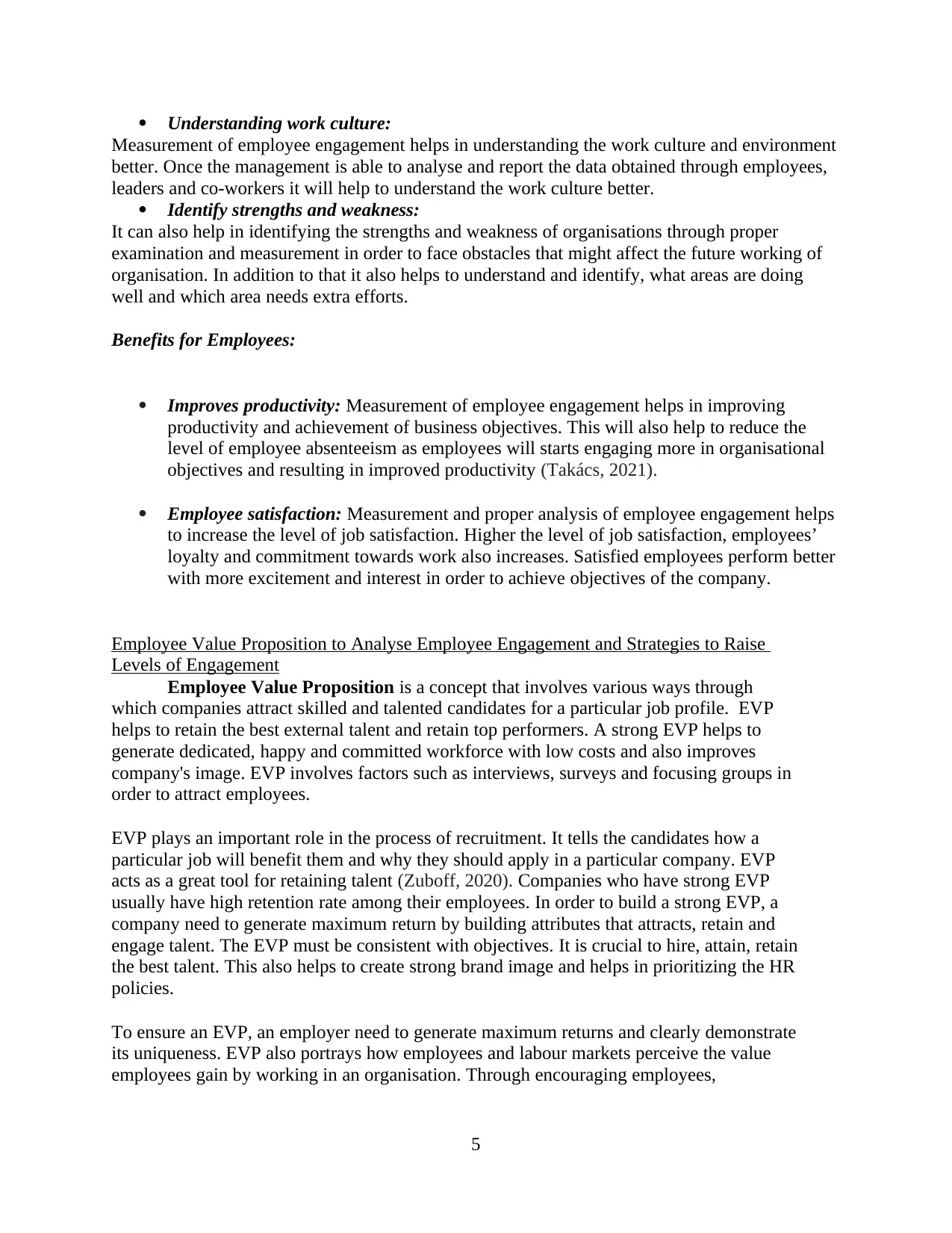
Understanding work culture:
Measurement of employee engagement helps in understanding the work culture and environment
better. Once the management is able to analyse and report the data obtained through employees,
leaders and co-workers it will help to understand the work culture better.
Identify strengths and weakness:
It can also help in identifying the strengths and weakness of organisations through proper
examination and measurement in order to face obstacles that might affect the future working of
organisation. In addition to that it also helps to understand and identify, what areas are doing
well and which area needs extra efforts.
Benefits for Employees:
Improves productivity: Measurement of employee engagement helps in improving
productivity and achievement of business objectives. This will also help to reduce the
level of employee absenteeism as employees will starts engaging more in organisational
objectives and resulting in improved productivity (Takács, 2021).
Employee satisfaction: Measurement and proper analysis of employee engagement helps
to increase the level of job satisfaction. Higher the level of job satisfaction, employees’
loyalty and commitment towards work also increases. Satisfied employees perform better
with more excitement and interest in order to achieve objectives of the company.
Employee Value Proposition to Analyse Employee Engagement and Strategies to Raise
Levels of Engagement
Employee Value Proposition is a concept that involves various ways through
which companies attract skilled and talented candidates for a particular job profile. EVP
helps to retain the best external talent and retain top performers. A strong EVP helps to
generate dedicated, happy and committed workforce with low costs and also improves
company's image. EVP involves factors such as interviews, surveys and focusing groups in
order to attract employees.
EVP plays an important role in the process of recruitment. It tells the candidates how a
particular job will benefit them and why they should apply in a particular company. EVP
acts as a great tool for retaining talent (Zuboff, 2020). Companies who have strong EVP
usually have high retention rate among their employees. In order to build a strong EVP, a
company need to generate maximum return by building attributes that attracts, retain and
engage talent. The EVP must be consistent with objectives. It is crucial to hire, attain, retain
the best talent. This also helps to create strong brand image and helps in prioritizing the HR
policies.
To ensure an EVP, an employer need to generate maximum returns and clearly demonstrate
its uniqueness. EVP also portrays how employees and labour markets perceive the value
employees gain by working in an organisation. Through encouraging employees,
5
Measurement of employee engagement helps in understanding the work culture and environment
better. Once the management is able to analyse and report the data obtained through employees,
leaders and co-workers it will help to understand the work culture better.
Identify strengths and weakness:
It can also help in identifying the strengths and weakness of organisations through proper
examination and measurement in order to face obstacles that might affect the future working of
organisation. In addition to that it also helps to understand and identify, what areas are doing
well and which area needs extra efforts.
Benefits for Employees:
Improves productivity: Measurement of employee engagement helps in improving
productivity and achievement of business objectives. This will also help to reduce the
level of employee absenteeism as employees will starts engaging more in organisational
objectives and resulting in improved productivity (Takács, 2021).
Employee satisfaction: Measurement and proper analysis of employee engagement helps
to increase the level of job satisfaction. Higher the level of job satisfaction, employees’
loyalty and commitment towards work also increases. Satisfied employees perform better
with more excitement and interest in order to achieve objectives of the company.
Employee Value Proposition to Analyse Employee Engagement and Strategies to Raise
Levels of Engagement
Employee Value Proposition is a concept that involves various ways through
which companies attract skilled and talented candidates for a particular job profile. EVP
helps to retain the best external talent and retain top performers. A strong EVP helps to
generate dedicated, happy and committed workforce with low costs and also improves
company's image. EVP involves factors such as interviews, surveys and focusing groups in
order to attract employees.
EVP plays an important role in the process of recruitment. It tells the candidates how a
particular job will benefit them and why they should apply in a particular company. EVP
acts as a great tool for retaining talent (Zuboff, 2020). Companies who have strong EVP
usually have high retention rate among their employees. In order to build a strong EVP, a
company need to generate maximum return by building attributes that attracts, retain and
engage talent. The EVP must be consistent with objectives. It is crucial to hire, attain, retain
the best talent. This also helps to create strong brand image and helps in prioritizing the HR
policies.
To ensure an EVP, an employer need to generate maximum returns and clearly demonstrate
its uniqueness. EVP also portrays how employees and labour markets perceive the value
employees gain by working in an organisation. Through encouraging employees,
5
Paraphrase This Document
Need a fresh take? Get an instant paraphrase of this document with our AI Paraphraser
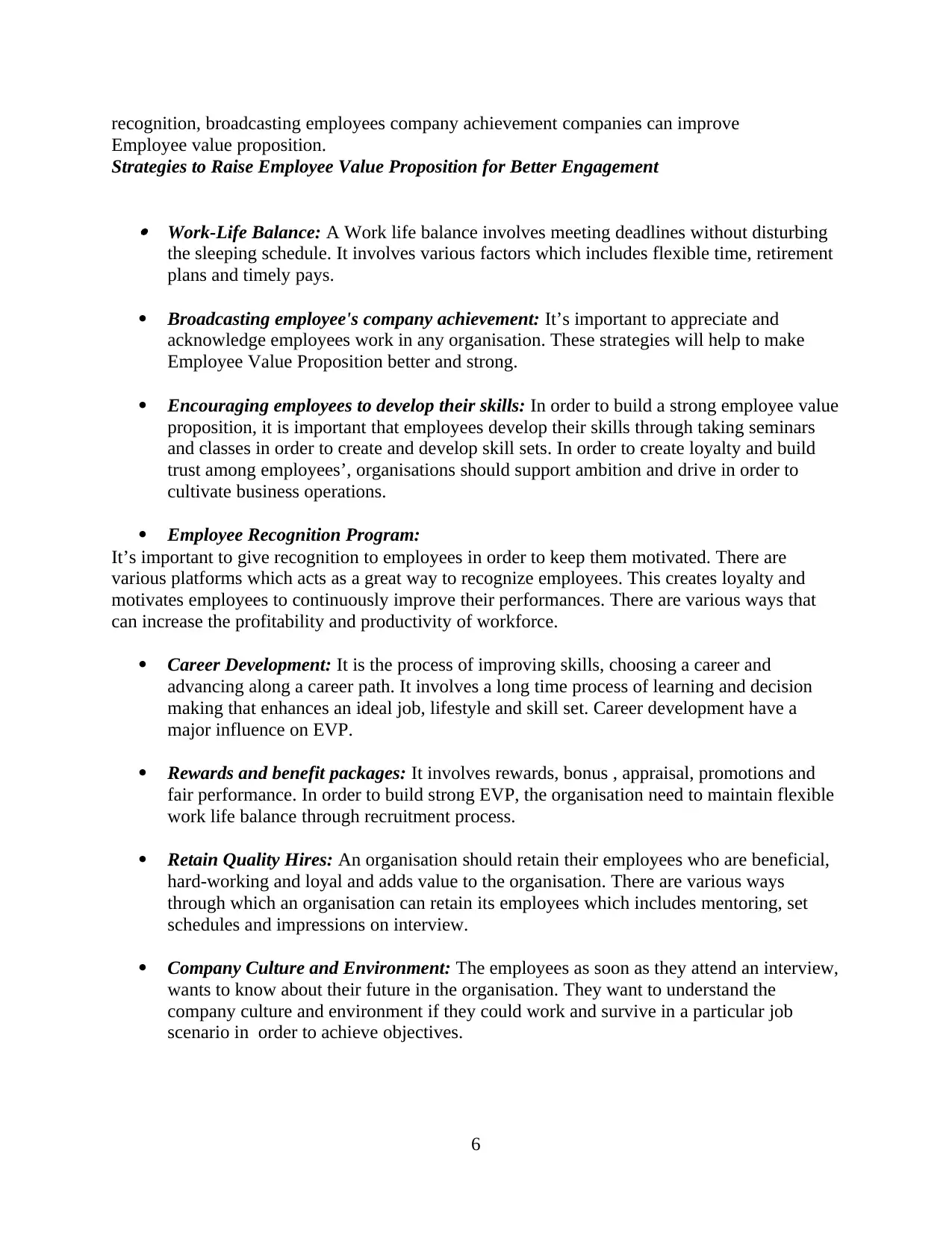
recognition, broadcasting employees company achievement companies can improve
Employee value proposition.
Strategies to Raise Employee Value Proposition for Better Engagement
Work-Life Balance: A Work life balance involves meeting deadlines without disturbing
the sleeping schedule. It involves various factors which includes flexible time, retirement
plans and timely pays.
Broadcasting employee's company achievement: It’s important to appreciate and
acknowledge employees work in any organisation. These strategies will help to make
Employee Value Proposition better and strong.
Encouraging employees to develop their skills: In order to build a strong employee value
proposition, it is important that employees develop their skills through taking seminars
and classes in order to create and develop skill sets. In order to create loyalty and build
trust among employees’, organisations should support ambition and drive in order to
cultivate business operations.
Employee Recognition Program:
It’s important to give recognition to employees in order to keep them motivated. There are
various platforms which acts as a great way to recognize employees. This creates loyalty and
motivates employees to continuously improve their performances. There are various ways that
can increase the profitability and productivity of workforce.
Career Development: It is the process of improving skills, choosing a career and
advancing along a career path. It involves a long time process of learning and decision
making that enhances an ideal job, lifestyle and skill set. Career development have a
major influence on EVP.
Rewards and benefit packages: It involves rewards, bonus , appraisal, promotions and
fair performance. In order to build strong EVP, the organisation need to maintain flexible
work life balance through recruitment process.
Retain Quality Hires: An organisation should retain their employees who are beneficial,
hard-working and loyal and adds value to the organisation. There are various ways
through which an organisation can retain its employees which includes mentoring, set
schedules and impressions on interview.
Company Culture and Environment: The employees as soon as they attend an interview,
wants to know about their future in the organisation. They want to understand the
company culture and environment if they could work and survive in a particular job
scenario in order to achieve objectives.
6
Employee value proposition.
Strategies to Raise Employee Value Proposition for Better Engagement
Work-Life Balance: A Work life balance involves meeting deadlines without disturbing
the sleeping schedule. It involves various factors which includes flexible time, retirement
plans and timely pays.
Broadcasting employee's company achievement: It’s important to appreciate and
acknowledge employees work in any organisation. These strategies will help to make
Employee Value Proposition better and strong.
Encouraging employees to develop their skills: In order to build a strong employee value
proposition, it is important that employees develop their skills through taking seminars
and classes in order to create and develop skill sets. In order to create loyalty and build
trust among employees’, organisations should support ambition and drive in order to
cultivate business operations.
Employee Recognition Program:
It’s important to give recognition to employees in order to keep them motivated. There are
various platforms which acts as a great way to recognize employees. This creates loyalty and
motivates employees to continuously improve their performances. There are various ways that
can increase the profitability and productivity of workforce.
Career Development: It is the process of improving skills, choosing a career and
advancing along a career path. It involves a long time process of learning and decision
making that enhances an ideal job, lifestyle and skill set. Career development have a
major influence on EVP.
Rewards and benefit packages: It involves rewards, bonus , appraisal, promotions and
fair performance. In order to build strong EVP, the organisation need to maintain flexible
work life balance through recruitment process.
Retain Quality Hires: An organisation should retain their employees who are beneficial,
hard-working and loyal and adds value to the organisation. There are various ways
through which an organisation can retain its employees which includes mentoring, set
schedules and impressions on interview.
Company Culture and Environment: The employees as soon as they attend an interview,
wants to know about their future in the organisation. They want to understand the
company culture and environment if they could work and survive in a particular job
scenario in order to achieve objectives.
6
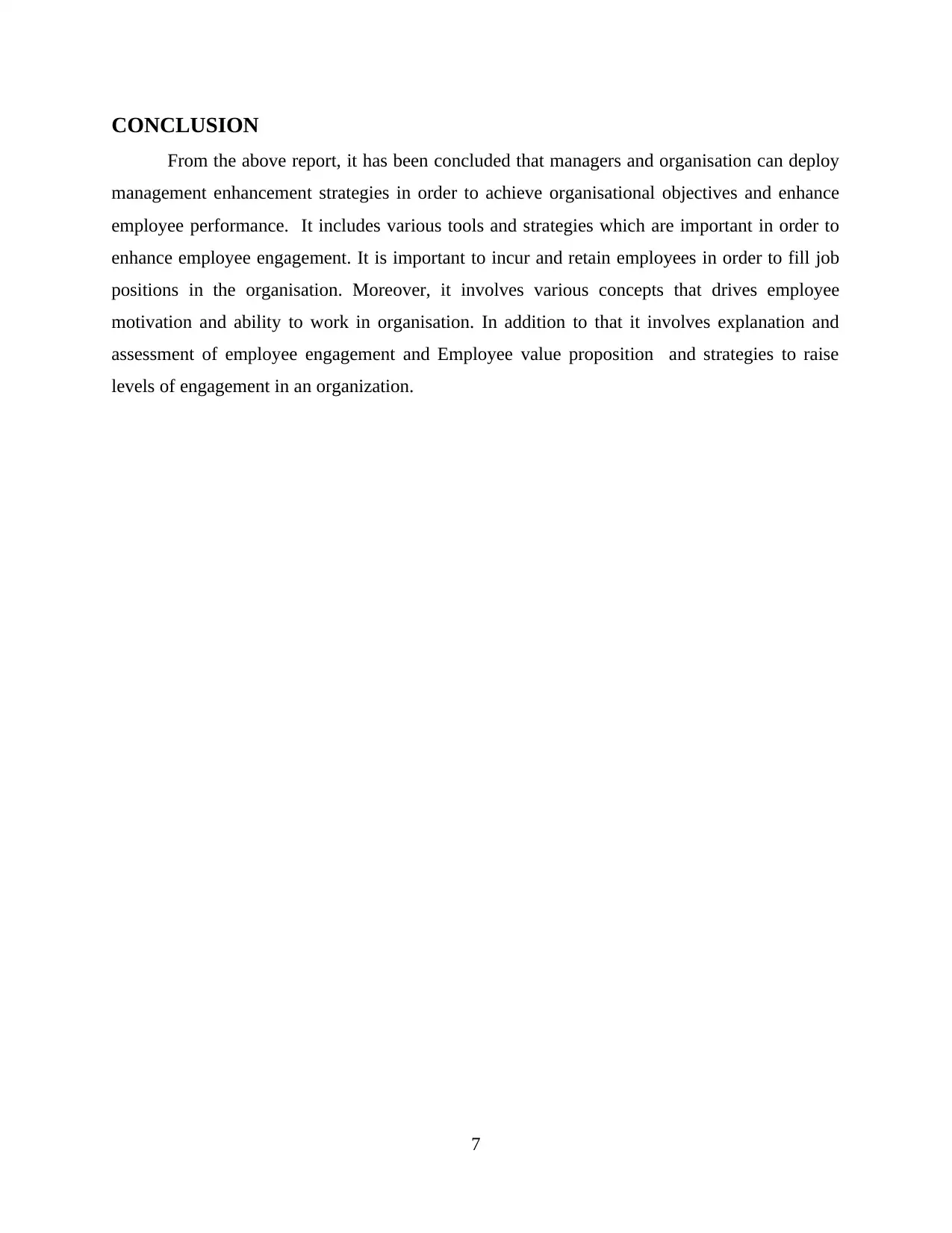
CONCLUSION
From the above report, it has been concluded that managers and organisation can deploy
management enhancement strategies in order to achieve organisational objectives and enhance
employee performance. It includes various tools and strategies which are important in order to
enhance employee engagement. It is important to incur and retain employees in order to fill job
positions in the organisation. Moreover, it involves various concepts that drives employee
motivation and ability to work in organisation. In addition to that it involves explanation and
assessment of employee engagement and Employee value proposition and strategies to raise
levels of engagement in an organization.
7
From the above report, it has been concluded that managers and organisation can deploy
management enhancement strategies in order to achieve organisational objectives and enhance
employee performance. It includes various tools and strategies which are important in order to
enhance employee engagement. It is important to incur and retain employees in order to fill job
positions in the organisation. Moreover, it involves various concepts that drives employee
motivation and ability to work in organisation. In addition to that it involves explanation and
assessment of employee engagement and Employee value proposition and strategies to raise
levels of engagement in an organization.
7
⊘ This is a preview!⊘
Do you want full access?
Subscribe today to unlock all pages.

Trusted by 1+ million students worldwide
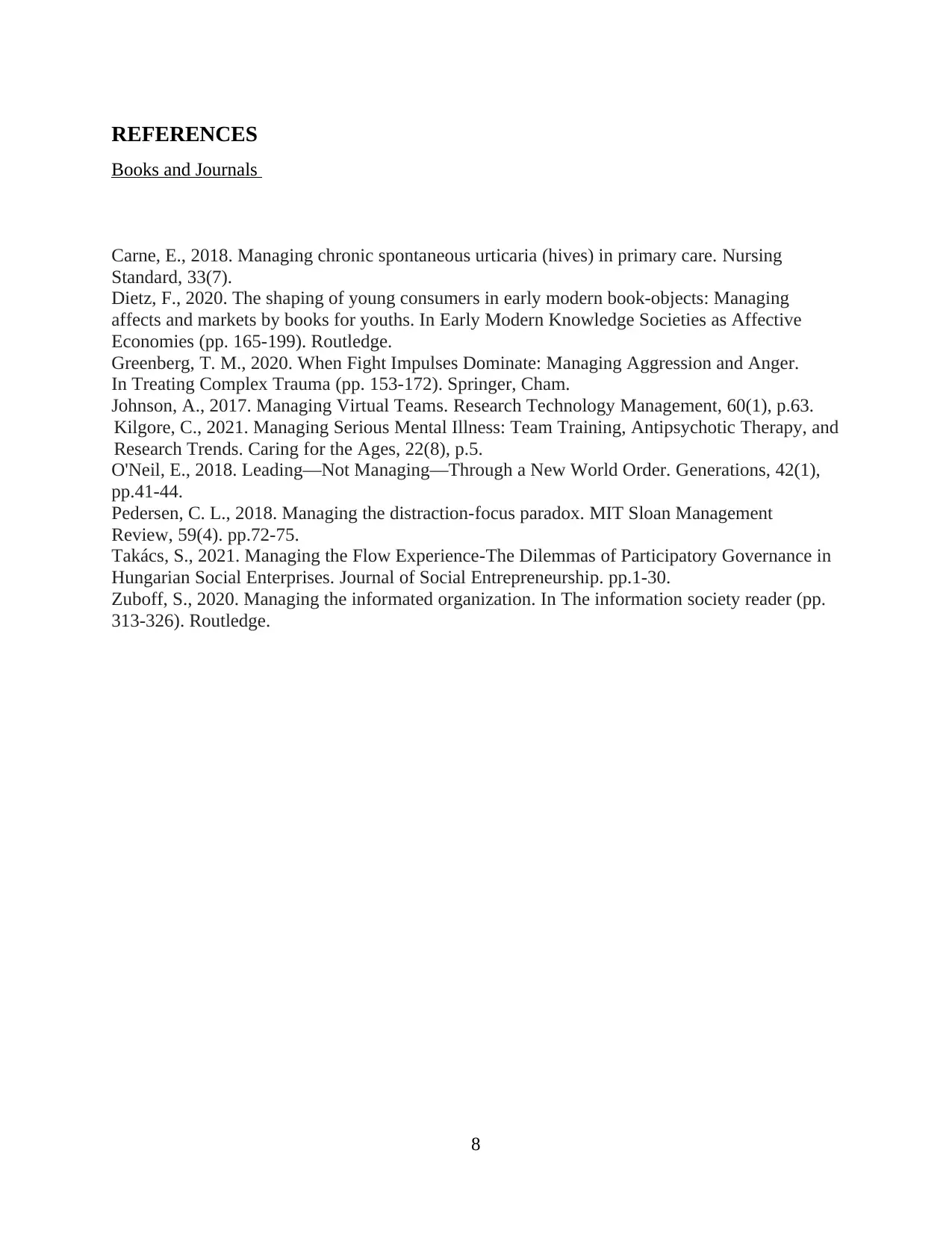
REFERENCES
Books and Journals
Carne, E., 2018. Managing chronic spontaneous urticaria (hives) in primary care. Nursing
Standard, 33(7).
Dietz, F., 2020. The shaping of young consumers in early modern book-objects: Managing
affects and markets by books for youths. In Early Modern Knowledge Societies as Affective
Economies (pp. 165-199). Routledge.
Greenberg, T. M., 2020. When Fight Impulses Dominate: Managing Aggression and Anger.
In Treating Complex Trauma (pp. 153-172). Springer, Cham.
Johnson, A., 2017. Managing Virtual Teams. Research Technology Management, 60(1), p.63.
Kilgore, C., 2021. Managing Serious Mental Illness: Team Training, Antipsychotic Therapy, and
Research Trends. Caring for the Ages, 22(8), p.5.
O'Neil, E., 2018. Leading—Not Managing—Through a New World Order. Generations, 42(1),
pp.41-44.
Pedersen, C. L., 2018. Managing the distraction-focus paradox. MIT Sloan Management
Review, 59(4). pp.72-75.
Takács, S., 2021. Managing the Flow Experience-The Dilemmas of Participatory Governance in
Hungarian Social Enterprises. Journal of Social Entrepreneurship. pp.1-30.
Zuboff, S., 2020. Managing the informated organization. In The information society reader (pp.
313-326). Routledge.
8
Books and Journals
Carne, E., 2018. Managing chronic spontaneous urticaria (hives) in primary care. Nursing
Standard, 33(7).
Dietz, F., 2020. The shaping of young consumers in early modern book-objects: Managing
affects and markets by books for youths. In Early Modern Knowledge Societies as Affective
Economies (pp. 165-199). Routledge.
Greenberg, T. M., 2020. When Fight Impulses Dominate: Managing Aggression and Anger.
In Treating Complex Trauma (pp. 153-172). Springer, Cham.
Johnson, A., 2017. Managing Virtual Teams. Research Technology Management, 60(1), p.63.
Kilgore, C., 2021. Managing Serious Mental Illness: Team Training, Antipsychotic Therapy, and
Research Trends. Caring for the Ages, 22(8), p.5.
O'Neil, E., 2018. Leading—Not Managing—Through a New World Order. Generations, 42(1),
pp.41-44.
Pedersen, C. L., 2018. Managing the distraction-focus paradox. MIT Sloan Management
Review, 59(4). pp.72-75.
Takács, S., 2021. Managing the Flow Experience-The Dilemmas of Participatory Governance in
Hungarian Social Enterprises. Journal of Social Entrepreneurship. pp.1-30.
Zuboff, S., 2020. Managing the informated organization. In The information society reader (pp.
313-326). Routledge.
8
Paraphrase This Document
Need a fresh take? Get an instant paraphrase of this document with our AI Paraphraser

9
1 out of 11
Related Documents
Your All-in-One AI-Powered Toolkit for Academic Success.
+13062052269
info@desklib.com
Available 24*7 on WhatsApp / Email
![[object Object]](/_next/static/media/star-bottom.7253800d.svg)
Unlock your academic potential
Copyright © 2020–2025 A2Z Services. All Rights Reserved. Developed and managed by ZUCOL.




